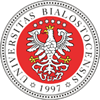Proszę używać tego identyfikatora do cytowań lub wstaw link do tej pozycji:
http://hdl.handle.net/11320/4927| Tytuł: | Podróże do serca islamu. Antologia międzywojennego reportażu polskich Tatarów |
| Inne tytuły: | Journeys to the Heart of Islam. An Anthology of Interwar Reportage by Polish Tatars |
| Redaktor(rzy): | Czerwiński, Grzegorz |
| Słowa kluczowe: | Tatarzy reportaż Bliski Wschód podróżopisarstwo islam Leon Najman-Mirza Kryczyński Edige Szynkiewicz Ali Ismail Woronowicz Mustafa Aleksandrowicz |
| Data wydania: | 2014 |
| Data dodania: | 20-gru-2016 |
| Wydawca: | Alter Studio |
| Seria: | Colloquia Orientalia Bialostocensia;10 Studia Tatarskie;3 |
| Abstrakt: | This book contains a selection of literary works by Polish Tatars which, in terms of genre, can be broadly classed as reportage. It includes works by four authors: Leon Kryczyński, Edige Szynkiewicz, Ali Woronowicz and Mustafa Aleksandrowicz. Alongside Travel Diaries by the mufti Jakub Szynkiewicz, these are the most important travel reportage texts written by Polish Muslims in the two decades between the World Wars. These pieces played an important role in enabling Poles to learn about the world of Islam in the years 1918–1939 (and their value as a source of knowledge remains current today), while for the Polish Tatars they also served as a description of an archetypical journey to the sources of their religious identity. The Tatars began to arrive in the territory of the Grand Duchy of Lithuania in the fourteenth century. To begin with they were chiefly prisoners-of-war, captured during the campaigns waged by Lithuanian forces against the Golden Horde. Soon, Tatar political emigrants also arrived. This occurred, for example, following the murder of Khan Berdibek in 1358, when a drawn-out battle for power began within the Horde, and the losers were compelled to leave the Tatar state and escape to Lithuania. The Tatars who settled in the Lithuanian lands were obliged to perform military service to the Grand Duke. Voluntary settlers – political refugees – also received the status of nobles, becoming the owners of feudal land as well as the peasants who lived there. In those times, the 15th and 16th centuries, Tatars were to be found chiefly in the regions of Vilnius, Kaunas, Grodno, Minsk and Novgorodok. As regards the later stages of Tatar settlement, mention should be made of the arrival in the 16th century of refugees from the Kazan and Astrakhan khanates, following the conquest of those lands by Ivan the Terrible. The new arrivals were settled in the royal Rus lands, the Kiev region, Podolia and Volyn. The last main wave of Tatar immigration took place following the Swedish invasions known as the Deluge. The Tatars living in the Polish-Lithuanian Commonwealth used a very wide variety of dialects of Kipchak (one of the Turkic languages), from which are descended the modern languages known as Tatar and Crimean Tatar. However, the years spent in their new homeland led to a large degree of assimilation, entailing above all the loss of their native language, which was replaced by Polish and Belarusian. The thing that enabled the Tatars to retain their separate ethnic identity was their religion, Islam. Over time, “Polish Muslims” became a synonym for “Tatars”. Even in the interwar decades, the Tatars were one of the smallest ethnic groups in Poland. At the beginning of the 20th century, as a result of the turbulent political events taking place in Eastern Europe and in Russia, the Tatars became scattered throughout the vast Russian Empire. They engaged in anti-Communist action, and in the work of the Tatar national government in Crimea, as well as the Azeri national government in Azerbaijan. After Poland regained its independence in 1918, they began to return to the eastern borderlands (the “Kresy”) of the new Republic. In that period, the Tatars’ socio-cultural and religious capital was Vilnius (Wilno). It was in that city in December 1925 that the All-Poland Congress of Muslim Communities took place, when a Grand Mufti was elected, as well as a legal committee tasked with drafting a decree by which the Polish government would recognise the Muslim Religious Association. The Polish Tatar Cultural and Educational Association was founded in Vilnius, and the city was also the home of the Tatar National Archive, the Tatar National Museum, and the magazine Życie Tatarskie. During the interwar years the Tatars established numerous contacts with fellow Muslims in the countries of the Middle East and south-eastern Europe. Tatar intellectuals (including Leon and Olgierd Kryczyński, Jakub Szynkiewicz, Stefan Bazarewski and others) made many journeys to Muslim countries and to Yugoslavia, Bulgaria and Romania, and helped organize visits by diplomats and socio-political activists from Islamic states, who were invited by the Polish national authorities. The first Polish Muslim pupils were sent to religious schools in Sarajevo, and two holders of master’s degrees in oriental studies from Lviv (Lwów), Ali Woronowicz and Mustafa Aleksandrowicz, went to Cairo to take up Koranic language studies. Cooperation also took place between Polish Muslims and political émigrés from Crimea, the Volga region and the Caucasus who were living in Poland. In the 1930s the Tatars began to develop a strong cultural movement and publishing activity. At the headquarters of the Polish Tatar Cultural and Educational Association, meetings and readings were held on the subject of the history of the Polish Muslims and the political, social and cultural situation in the countries of the East. An important part of these meetings was the talks given by those Tatars who had made journeys to Islamic countries. Socio-cultural and academic topics were also discussed in the pages of such magazines as Życie Tatarskie [“Tatar Life”] and Rocznik Tatarski [“Tatar Yearbook”]. To complete our picture of the life of the Polish Tatars in the era of the Second Republic of Poland, it should be added that at that time Tatars also held many important posts in government administration, or worked together with the central authorities in matters concerning Poland’s relations with the countries of the Middle East, while some, like Leon Bohdanowicz and Mustafa Aleksandrowicz, were delegated to work at Polish diplomatic missions (in the case of the two aforementioned, at the consulates in Algiers and Jerusalem respectively). During their foreign travels, Polish Muslims performed the function of official government representatives. Important diplomatic missions to the Middle East during the interwar years were undertaken by Jakub Szynkiewicz, who as the head of the Polish Muslims attended a meeting between foreign ministry advisor Edward Raczyński and King Ibn Saud of the Hijaz, and by Leon Kryczyński, who was received by the Sultan of Morocco.Leon Kryczyński went down in literary history as the author of the reportage Pod słońcem Maroka [“Under the Moroccan Sun”]. This work originally appeared in instalments in the Vilnius newspaper Słowo (1934), and was later published as a short book. In the same year a French translation of the work was published in Warsaw, under the title Sous le soleil du Maroc. Impressions de voyage. The work describes the author’s journey to Morocco undertaken in 1934. Kryczyński visited Casablanca, Rabat, Meknes and Fez. The chief event of his journey was a visit to the Sultan’s palace in Rabat, where Kryczyński was given an audience with Sultan Mohammad V. During the meeting Kryczyński described to the Sultan the situation of Poland and the Polish Muslims, emphasizing that relations between Muslims and the Polish government were excellent. At the end of the meeting the Sultan presented to Kryczyński a photograph of himself, with a dedication. The author also spends a lot of time describing the monuments of Islamic architecture in Morocco. He recalls that as a tourist he had prepared himself well for the journey, collecting the appropriate books and guides. The most interesting details, however, are not the historical facts contained in the text, but the author’s own observations and his experiences from his contacts with the local population. Another Polish Tatar author who published a reportage on his journeys to the East in the interwar period was Edige Szynkiewicz. His work Z podróży po Persji [“From Travel in Persia”] describes a winter journey from Tabriz to Tehran, a six-month stay in the capital, and the return journey towards the Turkish border. The journey takes on the character of the rovings of someone thirsty for adventure. The report includes nearly all of the indispensable elements of a “great adventure”, including a hazardous crossing of a snow-covered mountain pass, meetings with people met by chance on the way, nights spent in roadside inns, run-ins with gendarmes that nearly end in violence, and other similar events. In spite of the belligerent spirit of Szynkiewicz’s text, his work is surprising for the depth of the observations made concerning culture, mentality and everyday life in Persia. All this means that, while Szynkiewicz’s work is an easy and pleasant read, a reader looking in the text for the “reporter’s truth” will also not be disappointed. Other authors who became noted for their reportage and correspondence from abroad were the two students of Al-Azhar University in Cairo, Ali Woronowicz and Mustafa Aleksandrowicz. During their time in Egypt, both of them regularly wrote articles for Życie Tatarskie and other Polish newspapers, concerning the history, culture, customs and politics of the countries of the Middle East, including many texts that to a greater or lesser degree can be considered to represent the reportage genre. Ali Woronowicz wrote reports titled “Bayram”, “A Handful of Impressions from Egypt”, “The Egyptian Fellah”, “The Egyptian Woman”, “Images of Cairo”, “The Interior of the Muslim Temple”, and “Muslim Building in Al-Qahira”, while Mustafa Aleksandrowicz published “From a Journey to Egypt”, “Al-Azhar”, “Cairo, City of Contrasts”, “Mosques in Cairo”, “In the Land of the Great Deserts”, “The Social Order and Life of the Bedouin”, and “Chivalrous Customs of the Nomads”. The students of Al-Azhar produced reportage in many different forms. Some of their works are reports on their travels or on historical and sociological subjects. At other times their works combined reportage with popular scientific writing. The feature that binds together the whole of their Egyptian work is that it was produced “live” and on the spot, since even those pieces which could successfully have been written without a visit to Egypt (such as those on architecture and history) take on a distinct flavour of local colour. |
| Afiliacja: | Uniwersytet w Białymstoku |
| Sponsorzy: | Książka została przygotowana i wydana w ramach projektu badawczego „Literatura polsko-tatarska po 1918 roku”. Projekt finansowany ze środków Narodowego Centrum Nauki przyznanych na podstawie decyzji numer DEC-2012/07/B/HS2/00292. |
| URI: | http://hdl.handle.net/11320/4927 |
| ISBN: | 978-83-64081-11-8 |
| Typ Dokumentu: | Book |
| Występuje w kolekcji(ach): | Książki/Rozdziały (WFil) |
Pliki w tej pozycji:
| Plik | Opis | Rozmiar | Format | |
|---|---|---|---|---|
| Czerwiński_reportaż_DRUK.pdf | 2,92 MB | Adobe PDF | Otwórz | |
| Czerwiński_Raport_okładka_DRUK.pdf | 1,27 MB | Adobe PDF | Otwórz |
Pozycja jest chroniona prawem autorskim (Copyright © Wszelkie prawa zastrzeżone)

